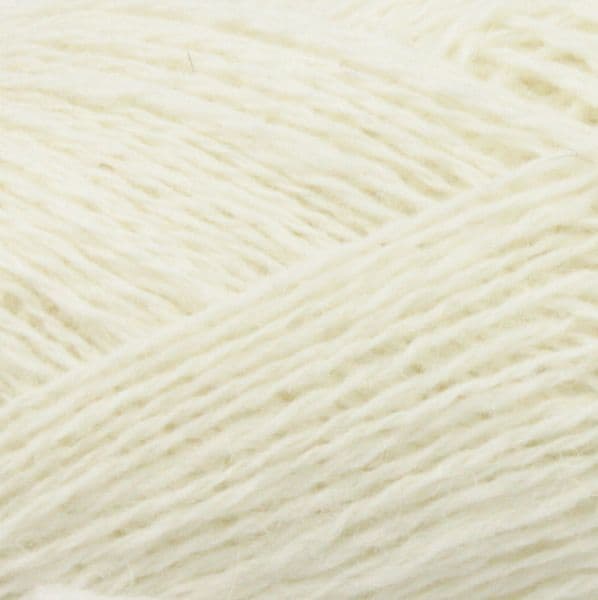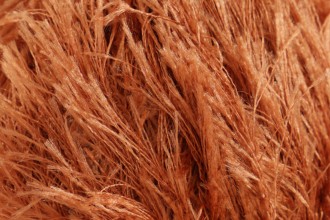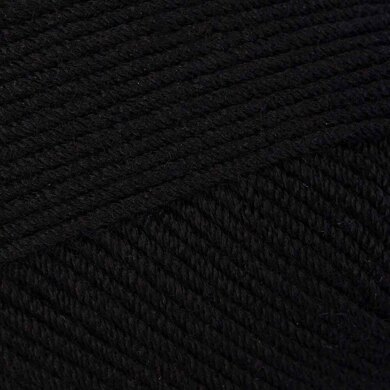Does your yarn split when you crochet? Can you easily pull the row out when you've made a mistake? Is fluff getting in your eyes? You could have chosen a bad yarn for crochet... or not. Read on to find out which yarns you should watch out for.
Here I'll show you my top 5 yarns that you should watch out for if you're a beginner and ways to stop your yarn from separating when you work with it.
1. Mohair or Suri Alpaca

While mohair and lace work perfectly for knitting, it can be a nightmare for crochet. I think this is because of the amount of handling you do with the fabric. You always have the fabric in your hand while you work the hook. It's also difficult to see the stitches beneath all of the fuzz.
2. Very fine yarn e.g. cobweb or lace.

As well as the stress of chaining such a fine yarn, you can miss stitches easily. You will also find that your tension is uneven with lace yarn as you accidentally loosen your grip to focus on getting into the chains. Leave it til later and stick with it for things that ask for motifs and lace stitches rather than a solid block.
3. Eyelash yarn

I get it. It's fun. It's on special offer in Aldi. This is great for making teddies in particular but if you can't see the stitches, you're doomed. Best avoided for beginners. You'll knot yourself into so much regret. Don't say I didn't warn you.
4. Single ply or roving types.

The problem with this is that, if you have really tight tension, you could pull it apart or split it. It's a pain. If you have accidentally knotted it at the wrong point or messed up a crochet stitch, it can be awful to try and get out of. Best avoided.
5. Dark coloured yarns

Can you think why I am saying black and dark yarns are best avoided if you are a beginner? I don't think I need to explain why.
What yarns should I use then?
It's all well and good me showing you what you shouldn't use but here's a list of yarns that you should use.
Acrylic DK
Now this depends purely on your preference of what you like to use and hold. Most beginners are fine using a DK acrylic yarn such as Stylecraft Special DK. It comes in every colour of the rainbow and is the top choice for blankets, scarves and other practical beginner sized projects.
If your acrylic cushion cover ends up on a 40 degree wash by mistake, you don't have to experience the trauma of shrinkage or felting. It's a good starter yarn.
Cotton DK
This is great if you are learning to make toys or spring/summer projects. Cotton can be quite hard on your hands as it isn't as bouncy as acrylic and wool, so adjust your crochet hook accordingly. Because it's not fluffy, it retains its shape well when stitched up. You can therefore see clearly where you're supposed to be putting your hook.

How can I stop yarn from splitting?
Yarn is blamed for splitting all of the time. You can prevent it splitting by the way that you hold it. If you have the yarn in your hand you can untwist it unknowingly. It can also depend on which end of the ball you are using. It's true that some yarns are just splittier than others and this is because of how it is spun. We can't help that if that's the case but I'll show you how to stop it from splitting here.
It may not always be the fault of the yarn
I once had a crochet tester pull out of the test because I'd chosen a "cheap, splitty yarn" for the design. It's quite a common misconception to think it is always the yarn that is at fault. Even the most luxurious feeling hand dyed yarns can separate and split.
Think about how yarns are spun. We have several strands (ply) of fibre that are twisted together over and over again to make a thicker, stronger yarn. They are twisted in one direction. If the yarn has been spun and twisted in a clockwise direction and you grab the end of it and start untwisting it as you work, what do you expect to happen?
Look at this yarn here. One end is from the inside of the ball and the other is from the outside of the ball. The one that came from the inside of the ball (right) is significantly looser than the one that came from outside of the ball. If I was to then start working with it as it is, it will be likely to separate and I'll split it with my hook. The yarn on the right is already on its way to being separated and therefore difficult to work with.
Both strands of this yarn are in the S twist direction (The opposite is the Z twist). I will still be working with this yarn but I have to be careful that I don't untwist the S twist. If you are lucky enough to work with a Z twist yarn, you will most likely add twist when you crochet.


You can't do anything about the direction of the twist unless you are also a spinner. I do not expect you to walk into a yarn shop and ask "where are the Z twist yarns? I only like those" I just want you to be aware that the direction of the ply will affect each project. Look out for it and be conscious of how you are working the yarn.
How can I avoid untwisting?
Because you are handling the yarn a lot as you work, you need to pay attention to your hand movements. All of us work the yarn in slightly different ways but some of us are guilty of accidentally twisting it in an anticlockwise direction.
Knitters will say it is because of how you are throwing or wrapping the yarn but in crochet we have an extra problem: no unified crochet hold. Some people barely touch the working yarn when they crochet while others have it held between forefinger and thumb. Other factors include the hand we use and how active our hand movements are. The more you touch it, the more it will twist or untwist.

This is what I mean by 'untwisting'. The yarn will separate and untwist. What you have to do to avoid this is to pay attention to how you work with the yarn. which end of the hank or ball did you grab the yarn from? What kind of yarn is it? Loose or tight?
When winding your own yarn out of a hank, pay attention to which end seems to be looser. Wind it in a way that the tighter end is the end you work with.
When opening a new ball of yarn, inspect the end that comes out of the centre and the end that is on the outside of the ball. Choose the tighter one.
You can also move your fingertips in a way that adds twist to the yarn as you work.

This is what we are aiming for. We need to hold the yarn in a way that compliments the direction in which it is twisting. Working against it won't help.
I've tried this but it still doesn't work
If you seem to split yarn no matter what you do, try looking out for yarns that specifically say "high twist" in their descriptions. This way, they will at least be harder for you to untwist.
There will always be yarns that we don't like and won't work for us. I'm not saying that there are no "cheap, splitty" yarns out there but we can at least try to identify if we are the problem first.
I hope this helps!
Hanna
See also:
Is crochet easier than knitting?

